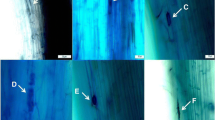Abstract
The effect of cacalol and extracts (water and petroleum ether) derived from the roots ofPsacalium decompositum (Asteraceae) on the germination and radicle growth of two plants.Amaranthus hypochondriacus (Amaranthaceae) andEchinochloa crusgalli (Poaceae), and on the radial growth of four phytopathogenic fungi is described. The activity of two cacalol derivatives (methyl cacalol and cacalol acetate) was also investigated. Germination ofA. hypochondriacus was inhibited by almost all the treatments. The extracts and cacalol produced a significant inhibition of radicle growth ofA. hypochondriacus andE. crusgalli. Cacalol acetate showed a specific inhibition onE. crusgalli, and methyl cacalol significantly inhibited the growth ofA. hypochondriacus. In general, antifungal activity depended upon the target fungi and the concentration of each treatment. Cacalol had also effects on the morphology and coloration of the fungal mycelium. The bioactivity shown by the extracts ofPsacalium decompositum on the tested seeds and fungi is mainly due to their content in cacalol.
Similar content being viewed by others
References
Agrios, G. N. 1991. Fitopatología. Editorial Noriega-Limusa. México, España, Venezuela, Argentina, Colombia, Puerto Rico.
Amo, S. del, andAnaya, A. L. 1978. Effect of some sesquiterpene lactones on the growth of certain secondary tropical species.J. Chem. Ecol. 4:305–313.
Amo, R. S. del, Anaya, A. L., andFernandez Luiselli, E. 1988. Aspectos ecológicos y económicos del amaranto, pp. 55–73,in S. del Amo (ed.). Cuatro Estudios sobre Sistemas Tradicionales. Instituto Nacional Indigenista. Serie de Investigaciones Sociales. Colección No. 17. México.
Anaya, A. L., andRovalo, M. 1976. Alelopatía en plantas superiores: diferencias entre el efecto de la presión osmótica y los alelopáticos sobre la germinación y el crecimiento de algunas especies de la vegetación secundaria de una zona cálido-húmeda de México, pp. 388–427,in A. Gómez-Pompa, C. Vázquez, S. del Amo, and A. Butanda (eds.). Investigaciones sobre la Regeneración de Selvas en Veracruz, México. Co. Ed. Continental, S.A. México.
Anaya, A. L., Ramos, L., Cruz, R., Hernández, J., andNava, V. 1987. Perspectives on Allelopathy in Mexican Traditional Agroecosystems: A case study in Tlaxcala.J. Chem. Ecol. 13(11):2083–2101.
Anaya, A. L., Hernández-Bautista, B. E., Pelayo-Benavides, H. R., Calera-Medina, M., andFernández-Luiselli, E. 1995. Allelopathy in Mexican plants: More recent studies, pp. 224–241,in Inderjit, K.M.M. Dakshini, and F.A. Einhellig (eds.). Allelopathy: Organisms, Processes, and Applications. American Chemical Society Symposium Series No. 582, Washington, D.C.
Bohlmann, F., andBapuji, M. 1982. Naturally occurring terpene derivatives. 387. Cacalol derivatives fromSenecio lyndenburgensis.Phytochemistry 21:681–683.
Bohlmann, F., andZdero, C. 1978. Naturally occurring terpene derivatives. 129. New cacalol derivatives fromRoldana heterogama.Phytochemistry 17:565–566.
Bohlmann, F., Dupre, S., andNordenstam, B. 1990. Cacalol derivatives from DominicanSenecio spp.Phytochemistry 29:3163–3166.
Duke, S. O. 1985. Weed Physiology, I and II. CRC Press, Boca Raton, Florida.
Duke, S. O. 1991. Plant terpenoids as pesticides, pp. 269–296,in R. F. Keeler and A. T. Tu (eds.). Handbook of Natural Toxins, Vol. 6. Marcel Dekker, New York.
Einhellig, F. A. 1985. Allelopathy—a natural protection, allelochemicals, pp. 161–200,in N. Bhushan Mandava (ed.). Handbook of Natural Pesticides: Methods, Vol. I, Theory, Practice, and Detection. CRC Press, Boca Raton, Florida.
El-Zik, K. M. andFrisbie, R. E. 1985. Integrated crops management systems for pest control, pp. 21–122,in N. Bhushan Mandava (ed.). Handbook of Natural Pesticides: Methods, Vol. I, Theory, Practice, and Detection. CRC Press, Boca Raton, Florida.
Fischer, N. H. 1991. Plant terpenoids as allelopathic agents, pp. 377–398,in J. B. Harborne and F.A. Tomas-Barberan (eds.). Ecological Chemistry and Biochemistry of Plant Terpenoids. Proceedings of the Phytochemical Society of Europe. Clarendon Press, Oxford.
Fischer, N. H., Williamson, G. B., Weidenhamer, J. D., andRichardson, D. R. 1994. In search of allelopathy in the Florida scrub: The role of terpenoids.J. Chem. Ecol. 20:1355–1380.
Griffin, D. H. 1994. Fungal Physiology, 2nd. ed. Wiley-Liss, New York.
Harborne, J. B. 1988. Introduction to Ecological Biochemistry, 3rd ed. Academic Press, London.
Harper, J. L. 1977. Population Biology of Plants. Academic Press, New York.
Jiménez-Estrada, M., Cruz-Lozano, R., Valdes, J. M., León-Cantero, J. R., Alarcón, G., andSveshtarova, B. P. 1992. Actividad antimicrobiana del cacalol y sus derivados.Rev. Latinoam. Quim. 22–23:14–17.
Langenheim, J. 1994. Higher plant terpenoids: A phytocentric overview of their ecological roles.J. Chem. Ecol. 20:1223–1280.
Leather, G. R., andEinhellig, F. A. 1985. Mechanisms of allelopathic action in bioassay, pp. 197–205,in A. C. Thompson (ed.). The Chemistry of Allelopathy. American Chemical Society, Washington, D.C.
Linares, E., andBye, R. A., Jr. 1987. A study of four medicinal plant complexes of Mexico and adjacent United States.J. Ethnopharmacol. 19:153–183.
Lotina-Hennsen, B., Roque-Reséndiz, J. L., Jiménez, M., andAguilar, M. 1991. Inhibition of oxygen evolution by cacalol and its derivatives.Z. Naturforsch. 46:777–780.
Macías, F. A., Galindo, G. J. C., andMassanet, G. M. 1992. Potential allelopathic activity of several sesquiterpene lactone models.Phytochemistry 31:1969–1977.
Picman, A. K. 1986. Biological activities of sesquiterpene lactones.Biochem. Syst. Ecol. 14:255–281.
Pippen, R. W. 1968. Mexican “cacalioid” genera allied toSenecio (Compositae).Contrib. U.S. Natl. Herb. 34:365–447.
Putnam, A. R., andTang, C. S. (eds.). 1986. The Science of Allelopathy. John Wiley, New York.
Rice, E. L. 1984. Allelopathy. Academic Press, Orlando.
Ritchie, G. A. (ed.). 1979. New Agricultural Crops. AAAS Selected Symposium, Westview Press, Colorado.
Rizvi, S. J. H., andRizvi, V. 1992. Exploitation of allelochemicals in improving crop productivity, pp. 443–472,in S. J. H. Rizvi and V. Rizvi (eds.). Allelopathy: Basic and Applied Aspects. Chapman and Hall, London.
Romo, J., andJoseph-Nathan, P. 1964. The constituents ofCacalea decomposita A. Gray. Structures of cacalol and cacalome.Tetrahedron 20:2331.
Thompson, A. C. (ed.). 1985. The Chemistry of Allelopathy. Biochemical Interactions between Plants. American Chemical Society Symposium Series 268, Washington, D.C.
Waller, G. R. (ed.). 1987. Allelochemicals: Role in Agriculture and Forestry. American Chemical Society Symposium Series 330, Washington, D.C.
Author information
Authors and Affiliations
Rights and permissions
About this article
Cite this article
Anaya, A.L., Hernández-Bautista, B.E., Torres-Barragán, A. et al. Phytotoxicity of cacalol and some derivatives obtained from the roots ofPsacalium decompositum (A. Gray) H. Rob. & Brettell (Asteraceae), matarique or maturin. J Chem Ecol 22, 393–403 (1996). https://doi.org/10.1007/BF02033643
Received:
Accepted:
Issue Date:
DOI: https://doi.org/10.1007/BF02033643




